Prologue
London, the capital of the United Kingdom is well-known as the global epicenter, this vibrant city offers a whole variety of experiences, making this city one of the most desirable destinations in the world.
From majestic palaces and ancient fortresses to world-class museums and iconic neighborhoods, London’s most visited tourist attractions captivate the hearts and minds of explorers. In this comprehensive article, you’ll be introduced to London’s rich historical and cultural heritage.

The Tower of London
Standing along the banks of the River Thames, the Tower of London stands as a testament to centuries of fascinating history. For over 900 years, this iconic fortress has witnessed the rise and fall of empires, served as a royal residence, and held legendary prisoners.
Today, it offers visitors an extraordinary opportunity to traverse its ancient walls, explore the Crown Jewels, and immerse themselves in the intriguing stories of power, betrayal, and courage that echo within its hallowed halls.
The Tower of London is a remarkable fortress and UNESCO World Heritage site located on the north bank of the River Thames in central London. Its origins can be traced back to the year 1066 when William the Conqueror ordered its construction as a symbol of Norman power.
Throughout its history, the Tower has served various purposes, functioning as a royal palace, a treasury, an armory, and most famously, a prison. It gained a notorious reputation as a place of confinement and execution, with famous prisoners including Anne Boleyn, Sir Walter Raleigh, and Guy Fawkes.
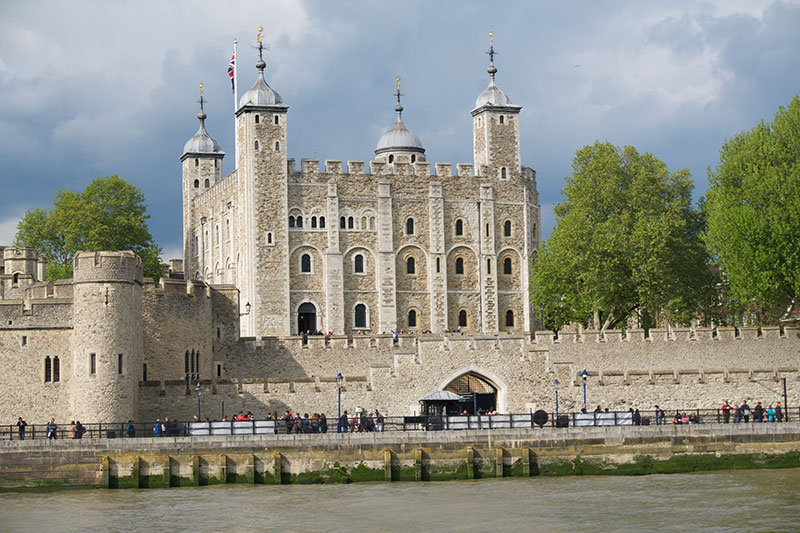
One of the most captivating aspects of the Tower is its impressive architecture. The complex comprises several towers, including the White Tower, which gives the fortress its name. Built-in the 11th century, the White Tower is a formidable structure with its massive stone walls and iconic turrets. Visitors can explore its interiors and marvel at medieval architecture, including the Chapel of St. John, the Royal Armories collection, and displays of historic weaponry and armor.
Another highlight of a visit to the Tower is the chance to see the Crown Jewels, which are kept in the Jewel House. The Crown Jewels represent a breathtaking collection of regalia and precious gems, including crowns, scepters, and orbs that have been used in crowning and other royal ceremonies throughout the centuries. The exhibition provides a fascinating glimpse into the luxury and symbolism of the British monarchy.
To improve the visitor experience, the Tower of London offers engaging guided tours led by the Yeoman Warders, also known as Beefeaters. These ceremonial guardians share captivating stories, legends, and historical anecdotes, bringing the rich history of the Tower to life.
Buckingham Palace
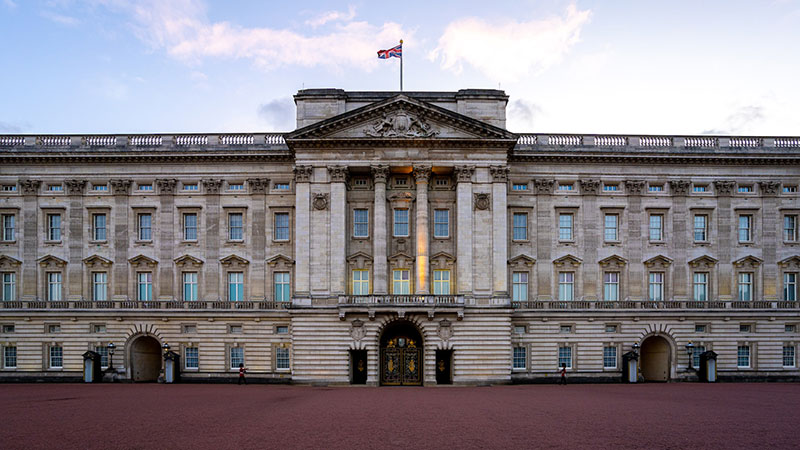
Famous and inspiring, Buckingham Palace is an official residence of British monarchs, this iconic palace has witnessed countless historic events and celebrations. Visitors flock to witness the world-renowned Changing of the Guard ceremony, an enthralling display of British pomp and tradition. The palace’s stately elegance and breathtaking architecture make it an unforgettable sight, exemplifying the splendor and majesty of the royal heritage.
Originally known as Buckingham House, the building was constructed in 1703 for the Duke of Buckingham. It was later acquired by King George III in 1761 as a private residence for Queen Charlotte. Over the years, the palace underwent significant expansions and renovations, transforming it into the grand palace we see today.
Buckingham Palace has an impressive facade with its neoclassical design and iconic balcony. The facade is adorned with stunning sculptures and intricate details that reflect the architectural style of the time. The palace features over 775 rooms, including lavish staterooms, private apartments, and staff quarters.
One of the most popular attractions at Buckingham Palace is the Changing of the Guard ceremony. This traditional ceremony takes place daily during the summer months and on alternate days during the rest of the year.
It is a spectacular display of British pageantry, where the guards, dressed in their distinctive red tunics and bearskin hats, ceremoniously change duty. Visitors flock to witness this captivating event, as the guards march to the rhythm of military bands and perform precision drills.
During the summer months, a portion of the palace, known as the State Rooms, is open to the public. This allows visitors to step inside and experience the opulence and grandeur of the royal residence. The State Rooms are adorned with exquisite artworks, luxurious furnishings, and ornate decorations, creating a visual feast for visitors. Highlights of the tour include the Grand Staircase, the Throne Room, and the Picture Gallery, which houses an extensive collection of paintings by renowned artists.
Buckingham Palace also serves as a venue for significant royal ceremonies and events. These include state banquets, investments, and garden parties, where dignitaries, heads of state, and members of the public gather to celebrate special occasions.
In addition to its architectural splendor, Buckingham Palace sits beautifully landscaped gardens, which cover an area of about 16000 Hectares. The gardens feature manicured lawns, vibrant flower beds, and serene lakes, providing a tranquil oasis in the heart of bustling London.
Buckingham Palace holds a special place in the hearts of the British people and visitors alike. Its grandeur, historical significance, and connection to the monarchy make it an essential stop on any tour of London, offering a glimpse into the world of the British royal family.
The Houses of Parliament and Big Ben
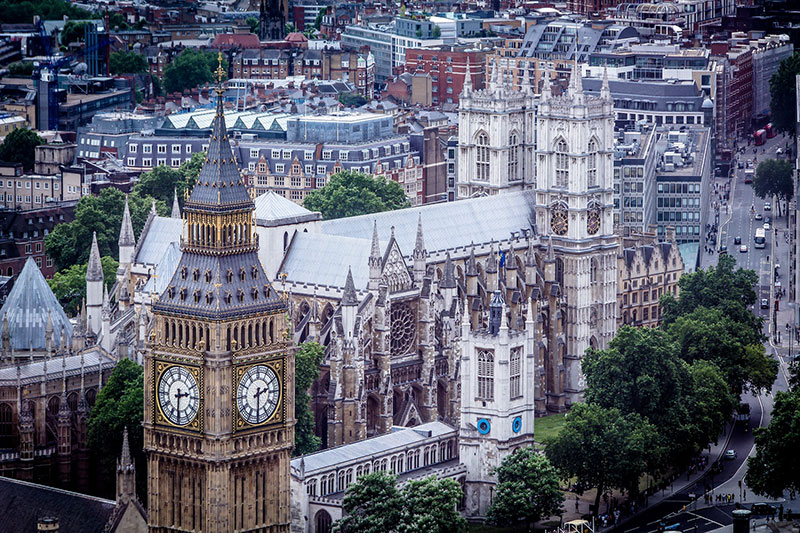
Located on the banks of the River Thames, the Houses of Parliament and the resounding chimes of Big Ben highlights the democratic heart of the United Kingdom. Admired for their architectural splendor, these historic institutions offer guided tours that provide a glimpse into the inner workings of British governance. The sight of Big Ben, its melodious peals resonating through the city, has become an iconic symbol of London’s enduring spirit and indomitable character.
The history of the Palace of Westminster dates back to the 11th century when it was originally a royal residence. However, a devastating fire in 1834 destroyed much of the original structure, and it was subsequently rebuilt in its current neo-Gothic style by architect Charles Barry.
One of the most iconic features of the Houses of Parliament is the Elizabeth Tower, commonly referred to as Big Ben. Contrary to popular belief, Big Ben is the nickname of the Great Bell housed within the clock tower, not the tower itself. The tower was officially renamed the Elizabeth Tower in 2012 to honor Queen Elizabeth II’s Diamond Jubilee.
Standing at a height of 96 meters (316 feet), the Elizabeth Tower is a prominent landmark in London’s skyline. It features elaborate stonework, pointed arches, and intricate carvings, showcasing the architectural grandeur of the Victorian era. The clock faces of Big Ben are among the largest and most famous in the world, with each dial measuring about 7 meters (23 feet) in diameter.
Visitors to the Houses of Parliament can explore its historic chambers and learn about the political process through guided tours. The tours provide insight into the functioning of the UK Parliament, the history of the building, and the democratic system of governance. The highlight of these tours is often the opportunity to witness the famous Big Ben striking the hour, accompanied by its melodious chimes that have become an enduring symbol of London.
The Houses of Parliament and Big Ben play a vital role in the democratic tradition of the United Kingdom. It is within these walls that laws are debated, decisions are made, and the country’s governance takes shape. The architectural splendor of the building, coupled with its historical significance, attracts visitors from around the world who are fascinated by the workings of British democracy and the iconic appearance of Big Ben.
The location of the Houses of Parliament, overlooking the River Thames and situated near other renowned attractions such as Westminster Abbey and the London Eye, makes it a central part of London’s cultural and historical landscape. It offers visitors a glimpse into the heart of British politics, an appreciation for architectural excellence, and the opportunity to witness the timeless beauty and resounding bells of Big Ben.
Westminster Abbey
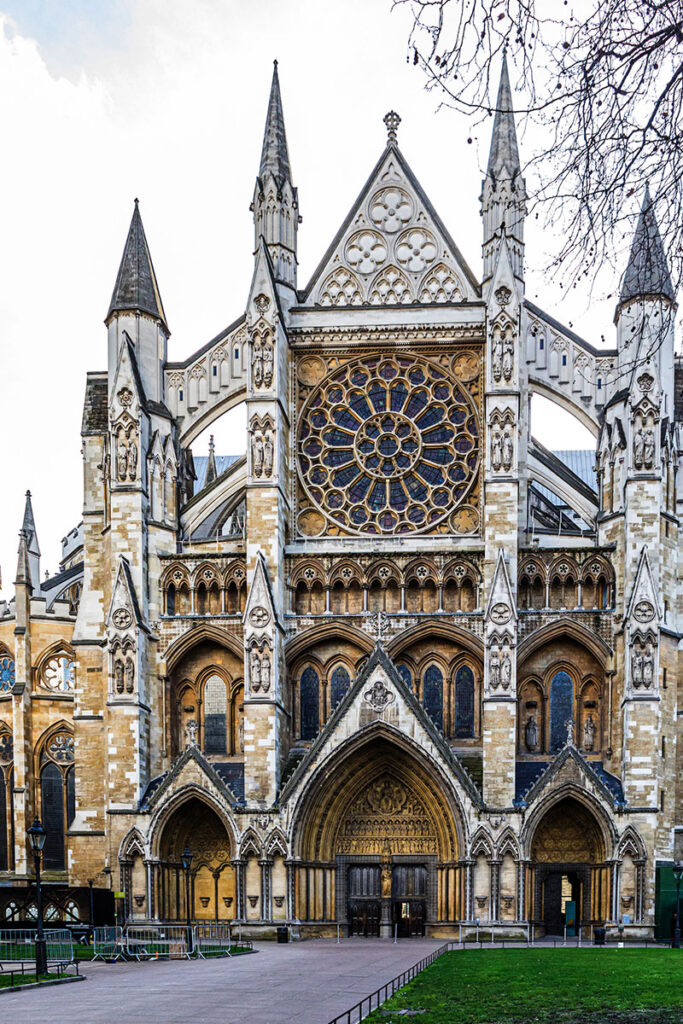
Located in the heart of London, is one of the most significant and historic religious buildings in the United Kingdom. It has been the coronation church of British monarchs since 1066 and is the final resting place of numerous notable figures from British history.
The history of Westminster Abbey dates back over a thousand years. Its origins can be traced to the 7th century when a small Benedictine monastery was established on the site. The current Gothic-style abbey that stands today was primarily constructed between the 13th and 16th centuries, with subsequent additions and renovations.
The architecture of Westminster Abbey is a marvel of intriguing design and craftsmanship. Its soaring spires, towering stained glass windows, and ornate stone carvings showcase the Gothic architectural style at its finest
One of the most notable attractions within Westminster Abbey is the Coronation Chair, located in the medieval Chapel of St. Edward the Confessor. This ancient wooden chair, commissioned by King Edward I in 1296, has been used in every British crowning since 1308. It is a powerful symbol of monarchy and continuity, and its historic importance is noticeable within the abbey walls.
Westminster Abbey is renowned for its Poets’ Corner, a section of the abbey where many literary figures and poets are buried or commemorated. Notable names include Geoffrey Chaucer, William Shakespeare, Charles Dickens, and Rudyard Kipling. The abbey is a place of reverence for literature and a pilgrimage site for admirers of these great literary figures.
The abbey also houses numerous memorials and monuments dedicated to prominent individuals who have contributed to the arts, sciences, politics, and military history of the United Kingdom. These memorials serve as a testament to the nation’s rich heritage and pay homage to the achievements of remarkable individuals.
Beyond its historical and religious significance, Westminster Abbey remains an active place of worship, hosting special religious ceremonies, royal weddings, and state funerals. It continues to play a central role in the nation’s cultural and ceremonial life
London’ Eye
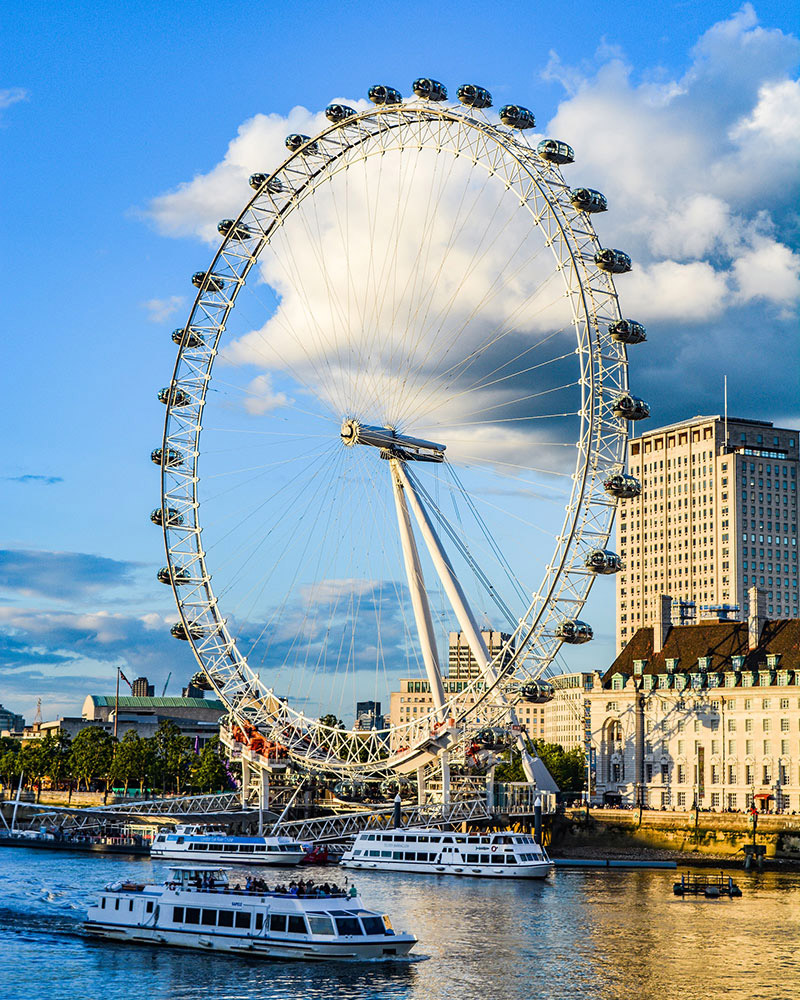
The London Eye, also known as the Millennium Wheel, stands tall as an iconic observation wheel gracing the South Bank of the River Thames in London. Since its inauguration in the year 2000, it has emerged as one of the most sought-after tourist attractions in the city, becoming a prominent feature of London’s captivating skyline.
Rising to an impressive height of 135 meters (443 feet), the London Eye held the distinction of being the world’s tallest Ferris wheel at the time of its construction. Crafted by a team of visionary architects, engineers, and designers, including the talents of David Marks and Julia Barfield, the wheel boasts 32 splendid glass capsules, each capable of accommodating up to 25 passengers.
What draws countless visitors to the London Eye is the unparalleled opportunity to soak in breathtaking panoramic vistas of the city. As the wheel gracefully rotates, patrons are treated to an awe-inspiring 360-degree outlook, offering sweeping views of London’s most celebrated landmarks.
From the majestic Houses of Parliament and the regal Buckingham Palace to the iconic St. Paul’s Cathedral and the magnificent Tower Bridge, the vistas from the London Eye are simply unforgettable, with visibility stretching up to an astounding 40 kilometers (25 miles) on clear days.
The British Museum
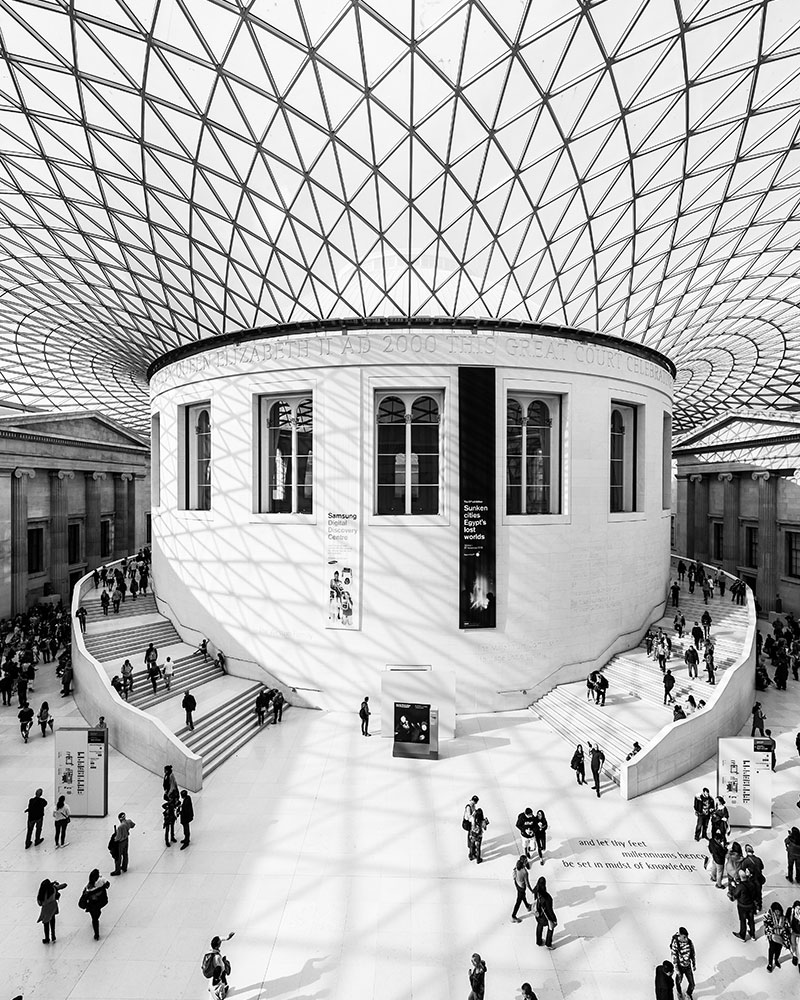
Home to an astonishing collection of art, artifacts, and antiquities, the British Museum is a treasure trove for history enthusiasts. From the Rosetta Stone to the Elgin Marbles, the museum houses a vast array of exhibits that span centuries and continents. Its majestic Great Court and the Enlightenment Gallery are architectural marvels in themselves, visiting the British Museum an unforgettable experience.
The museum building itself is an architectural masterpiece. Designed in a neoclassical style by Sir Robert Smirke, it features a grand colonnaded facade and a prominent central dome that adds to its majestic presence. Over the years, the museum has undergone expansions and renovations to accommodate its growing collection and provide the best possible visitor experiences.
The museum’s collection spans over two million years of history, showcasing objects from ancient civilizations, including Egypt, Greece, Rome, Mesopotamia, and many others. From the Rosetta Stone to the Elgin Marbles, the British Museum is home to some of the most significant and iconic artifacts in the world.
The British Museum is organized into various departments and galleries, each dedicated to specific periods, regions, or themes. Some of the notable departments include Ancient Egypt and Sudan, Ancient Greece and Rome, the Middle East, Asia, Africa, and Europe. Visitors can explore these galleries and delve into the diverse cultures, art, and history of different civilizations throughout the ages.
Conclusion
London stands as one of the most popular destinations in the world. Its most-visited attractions offer a unique insight into the historical and cultural heritage of this magnificent city. Whether you are fascinated by ancient artifacts, royal splendor, literary treasures, or breathtaking vistas, London has something to offer everyone.
So, don’t miss the opportunity to explore this dynamic city, where tradition meets innovation and where the echoes of the past harmonize with the rhythms of the present. If you have eagerness and time check out other attractive destinations in Europe, (read more)






